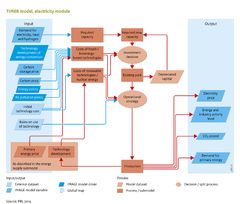Energy conversion/Policy issues: Difference between revisions
Jump to navigation
Jump to search
Oostenrijr (talk | contribs) No edit summary |
No edit summary |
||
| Line 6: | Line 6: | ||
* An imposed minimum or maximum share per energy source - renewable energy, CCS technology, nuclear power and other forms of power generation. This would directly influence the capacity installed for each option. | * An imposed minimum or maximum share per energy source - renewable energy, CCS technology, nuclear power and other forms of power generation. This would directly influence the capacity installed for each option. | ||
* Promoting the use of electricity and hydrogen on end-user level. With the high flexibility in the choice of feedstock in these systems, large proportions of electricity and hydrogen use in final energy would increase the ability of the total system to reduce greenhouse gas emissions. | * Promoting the use of electricity and hydrogen on end-user level. With the high flexibility in the choice of feedstock in these systems, large proportions of electricity and hydrogen use in final energy would increase the ability of the total system to reduce greenhouse gas emissions. | ||
The exclusion of certain power-generation options for environmental and/or security reasons ([[Kruyt et al., 2009]]). | * The exclusion of certain power-generation options for environmental and/or security reasons ([[Kruyt et al., 2009]]). | ||
Model analyses show that a high proportion of emission reductions would be achieved through supply side changes. The capacity for different supply-side options under the baseline scenario and various pathways consistent with the 2 °C climate change target are presented in the figure below. | Model analyses show that a high proportion of emission reductions would be achieved through supply side changes. The capacity for different supply-side options under the baseline scenario and various pathways consistent with the 2 °C climate change target are presented in the figure below. | ||
Revision as of 17:30, 9 November 2016
Parts of Energy conversion/Policy issues
| Component is implemented in: |
|
| Related IMAGE components |
| Projects/Applications |
| Models/Databases |
| Key publications |
| References |
